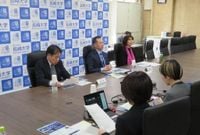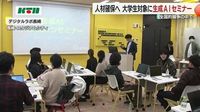Nagasaki Prefecture is embracing the potential of generative AI as local initiatives pave the way for a new wave of digital talent development. On March 21, 2025, a seminar was organized for university students, focusing on the intricacies of generative AI and its practical applications.
BeeWiz Co., Ltd., which operates "Digital Labo Nagasaki," led the seminar aimed at enlightening university students about the importance of generative AI technology in business. This seminar attracted about ten eager participants from various higher education institutions across the prefecture. The event kicked off with sessions discussing generative AI applications, highlighting efforts to create tourism-focused AI tailored for the Nagasaki Studio City region.
The Digital Labo Nagasaki initiative was established in 2022 with the goal of nurturing digital professionals to meet the growing demand in tech industries. The seminar emphasized developing applications that might enhance tourism in the region, demonstrating how academia and technology can collaborate for mutual benefit.
"There are many aspects I am experiencing for the first time and it is exciting," said a graduate student from Nagasaki Institute of Applied Science, reflecting on the enlightening experience. Another participant, a second-year economics student at Nagasaki University, noted, "I usually encounter ChatGPT in my studies, though educational institutions have discouraged its use in reports, making participation in such training sessions invaluable in expanding my knowledge."
BeeWiz aims to recruit engineers with a local focus, particularly as technologies evolve, responding to the nationwide shortage of skilled tech professionals. The company's strategy aligns with Nagasaki Prefecture’s research and education sectors, cultivating talent in an area rich with information systems students. "I believe that various tech companies will congregate, pooling elite engineers in the Nagasaki Stadium City. If we can collaborate across floors, that would create a fascinating dynamic," remarked Masahiko Ito, an executive officer at BeeWiz, highlighting the potential synergies among local tech firms.
As BeeWiz further strengthens its training programs, Digital Labo Nagasaki currently has 11 active members, with plans to onboard additional individuals annually to bolster its mission to fulfill local needs.
In parallel, Nagasaki University has been instrumental in fostering diversity in academia, specifically increasing female representation among faculty members. On March 6, 2025, the university held the final reporting session for its Diversity Promotion Project. Approximately 60 participants joined the event online, where the university presented successful outcomes from a six-year initiative funded by JST.
By May 1, 2024, female faculty enrollment at the university hit 25.7%, marking the third consecutive year of achieving the highest rate among the country’s 46 national comprehensive universities. This achievement underscores the university's commitment to diversity and inclusion within academic environments.
The reporting session showcased the progress made, completing their set targets. Five researchers who leveraged center support presented their findings and discussed the evolution of female leaders. The session included valuable contributions from three medical departments that participated in a reform program aimed at redefining workplace culture in hospitals, sharing their latest case studies.
Yasuko Yamamura, program manager for JST, commended the increased enrollment of female researchers and the proactive initiatives enhancing work environments. Using the platform, President of Nagasaki University, Takeharu Nagayasu, concluded the session with a firm commitment to continue the diversity endeavors, expressing gratitude to all those involved in this initiative. "We aim to strengthen the Diversity Promotion Center's influence in our future efforts," he stated, reinforcing the university’s ongoing mission to advance diversity.
For those interested in the detailed reports, additional information can be found on the Center’s website.


